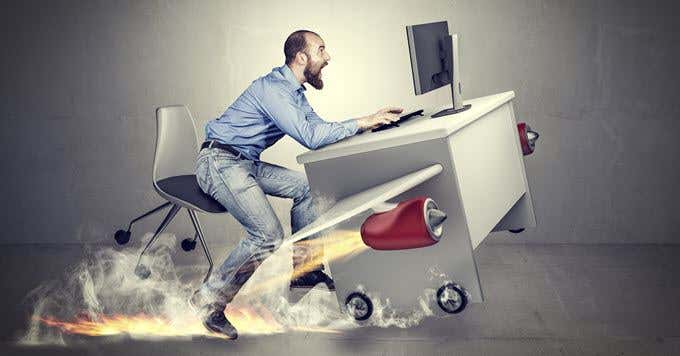
Personal Computers and laptops have finite lifespans; over time, both software and hardware deteriorate, resulting in slower performance and a subpar user experience. While you may not achieve the same level of performance as when you first purchased your device, significant improvements are still attainable through simple tweaks or upgrades.
Additionally, neglecting proper PC maintenance can lead to accumulation of obsolete data, viruses, or hardware issues, all of which contribute to system slowdowns. Fortunately, these issues can be rectified with dedicated attention and adherence to our provided tips.
Below are simple tips to significantly increase performance. Follow these tips and you’ll see positive results.
How to Speed up Your PC/Laptop
1. Restart Your PC
Before tinkering with hardware or software, give your PC a fresh start. While running, your PC undergoes many processes, some continuing in the background even after program closure.
Restarting clears processes, providing a clean slate. Upon booting, there will be no additional processes until you open applications.
2. Keep It Cool
If your PC has been running constantly for the past 3 days (MMORPG farming may be important, but not worth the damage), then it deserves a rest. PCs slow down when they heat up, so turn it off completely for 2-3 hours before using it again.
If your PC heats up quickly, ensure its fan is clean and use a cooling pad for your laptop if necessary.
3. Optimize Computer Visuals for Better Performance
By default, Windows uses animations and attractive themes. To improve performance, set a basic theme and disable all visual effects. You can do this through the “Personalize” option in the context menu when you right-click on the desktop.
To optimize performance, either customize settings manually or utilize AVG PC Tune Up.
4. Opt for a Plain Desktop Background
If your PC’s performance is suffering, avoid using live wallpapers or screensavers. These visuals consume resources. Stick to the lightweight default Windows background.
5. Turn Off Windows 10 Update Bandwidth Distribution (For Windows 10 Users)
Windows 10 automatically shares downloaded updates with other users, draining bandwidth and resources, resulting in slower speeds. Fortunately, you can disable this feature.
To disable bandwidth distribution, navigate to “Settings” in the Start menu. Then, select “Update & Security”.
Next, access “Advanced options” under “Windows Update”. From there, choose “Choose how updates are delivered”.
Simply toggle the blue slider button to deactivate this feature.
6. Check for Malware and Viruses on Your PC
If your PC harbors Viruses, Malware, Spyware, or similar malicious software, it can significantly impair performance. These programs may operate surreptitiously in the background, compromising or exposing your data while consuming valuable system resources.
Ensure your PC stays clean by using a reliable antivirus and anti-malware program. Avast Antivirus and Malwarebytes are recommended tools for this purpose.
7. Registry Maintenance
Over time, Windows accumulates outdated entries in its registry, slowing down system processes. Simplify this task by utilizing registry cleaning tools.
One convenient and efficient option is Wise Registry Cleaner. With its one-click operation, it efficiently cleans and optimizes the registry.
8. Hard Drive Defragmentation
As you store data on your PC, it becomes scattered across the hard drive, hindering file retrieval. Defragmenting the hard drive organizes data for easier access.
Windows includes this feature built-in. Simply type “Disk Defragmenter” in the start menu search to find the tool. Run it on all your drives for a smoother performance. Alternatively, consider using a third-party defragmentation tool like IObit’s Smart Defrag for additional features.
9. Disable Startup Programs
Startup programs can slow down PC boot time and leave background processes that hinder performance. To disable them, press Windows+R and type “msconfig” in the “Run” dialog.
Now, go to the “Startup” tab to manage programs that launch with your PC. Uncheck unnecessary ones and click “OK” to confirm.
10. Clear Browser Data
While browsing, your browser stores temporary data on your PC, which can slow down performance and take up space. Use a tool like CCleaner to clean your PC and browser for a performance boost.
CCleaner is a renowned tool available for free. Download, scan, and delete unneeded data. Additionally, remove unwanted add-ons and extensions for improved browsing speed.
11. Opt Out of Google Chrome

While Google Chrome boasts top-tier browsing capabilities, its demanding resource consumption may overwhelm your PC, resulting in sluggish performance. Thankfully, numerous lightweight alternatives to Chrome offer comparable features without the resource strain.
Consider browsers such as Firefox, Opera, or Safari (for Mac users) as viable replacements for Chrome.
12. Eliminate Duplicate Files
Over time, your PC accumulates duplicate files—be it media, documents, or system files—due to copying and pasting between devices or similar actions. These redundant files serve no purpose, occupying valuable space and hindering system efficiency when searching for other data.
To view and eliminate duplicate files, consider using a reliable third-party duplicate file deleter like Duplicate Cleaner. This tool enables you to filter and remove duplicate files efficiently. However, exercise caution when deleting files, as you might unintentionally remove essential system files.
13. Utilize PC Performance Enhancement Software
Various PC performance enhancement tools, both free and paid, are available to optimize your system for peak performance. While these tools cannot perform miracles, they effectively eliminate unnecessary files and fine-tune system settings. Keep in mind that the extent of performance improvement depends on the condition of your PC.
The top tools for this purpose are IObit Advanced System Care Free and Glary Utilities. If you need more features, consider iolo System Mechanic.
14. Eliminate Unnecessary Programs
You may have installed programs you never need. These take up space and hinder system performance. To remove them, manually uninstall unwanted programs.
In Windows, search “Uninstall Programs” in the Start menu and select it. You’ll see a list of installed programs; double-click to uninstall.
Ensure your “Recycle bin” is empty to free up space, as deleted programs still occupy storage until removed from the bin.
15. Disable Background Processes
If any programs like cloud storage (Dropbox, Google Drive, One Drive, etc.), updaters, uploaders, or monitoring software are running in the background, disable them. Background processes consume your PC’s resources while you work on essential tasks, so it’s advisable to disable them when not in use.
16. Update to the Latest OS Version
Upgrade to the latest OS version available. For instance, Windows users should upgrade to Windows 10 (which is free). New OS versions provide enhanced stability, security, features, and performance.
Check system requirements before upgrading your OS to avoid performance issues.
Upgrade RAM
Running programs on your PC utilize its RAM. More programs require more RAM. Increase RAM by purchasing and adding more. Seek guidance at a computer shop if unsure.
Use ReadyBoost
Convert free space on a compatible USB flash drive into additional RAM for your PC using the “ReadyBoost” feature.
Simply insert a USB drive with at least 256 MB of empty space, then right-click and select “Properties”. If the USB is compatible, you’ll find a “ReadyBoost” tab. Navigate to it, choose “Use this device”, and adjust the RAM usage with the slider. Your PC will instantly utilize the specified space as additional RAM, significantly enhancing performance.
19. Opt for a Larger Hard Drive or SSD
Low on storage space? Improve performance by either freeing up space or investing in a bigger hard drive and transferring data. Consider upgrading to an SSD for even greater speed.
SSDs store data using chips, not physical parts, making them much faster than standard hard drives. However, they are nearly twice the price, so consider your decision carefully.
20. Reinstalling Windows
If you believe your PC is overloaded with unnecessary software, consider starting fresh by reinstalling Windows. Be sure to back up all important data before proceeding, as this process will erase all existing data.
You can initiate the reinstallation from the “Backup and Restore” option in Windows, effectively restoring it to its original factory settings.
21. Removing Bloatware
Bloatware, built-in programs added by software companies with PC purchases, aim to reduce machine costs, profiting the companies. These programs start up with your PC, consuming resources and space.
However, you aren’t obliged to keep them. Uninstall bloatware via the standard process, if unnecessary.
Factory resetting will reinstall bloatware. It’s advised to create a custom image post-bloatware removal.
Conclusion
Most mentioned methods are free and effective. Consider paid alternatives for best results. Know your PC’s limits. If it’s not powerful enough, it may struggle with tasks.
To check PC specifications, press Windows+R and type “Dxdiag” in “Run” dialog. This shows hardware and software specifications. Keep them in mind when running multiple or resource-intensive programs.
Note: Whether on Windows 10, 8.1, 8, 7, or XP, these tips will speed up your slow PC.

Pritam Chopra is a seasoned IT professional and a passionate blogger hailing from the dynamic realm of technology. With an insatiable curiosity for all things tech-related, Pritam has dedicated himself to exploring and unraveling the intricacies of the digital world.



